These Dampfnudeln Are Perfectly Plump And So Delicious!
Want to make German Dampfnudeln? We’ve got the Dampfnudel recipe for you!
These classic German dumplings are made with yeast dough, steamed to perfection, and can be enjoyed savory or sweet.
We like German steamed dumplings covered in a homemade vanilla sauce – but there are lots of other ways to enjoy them!
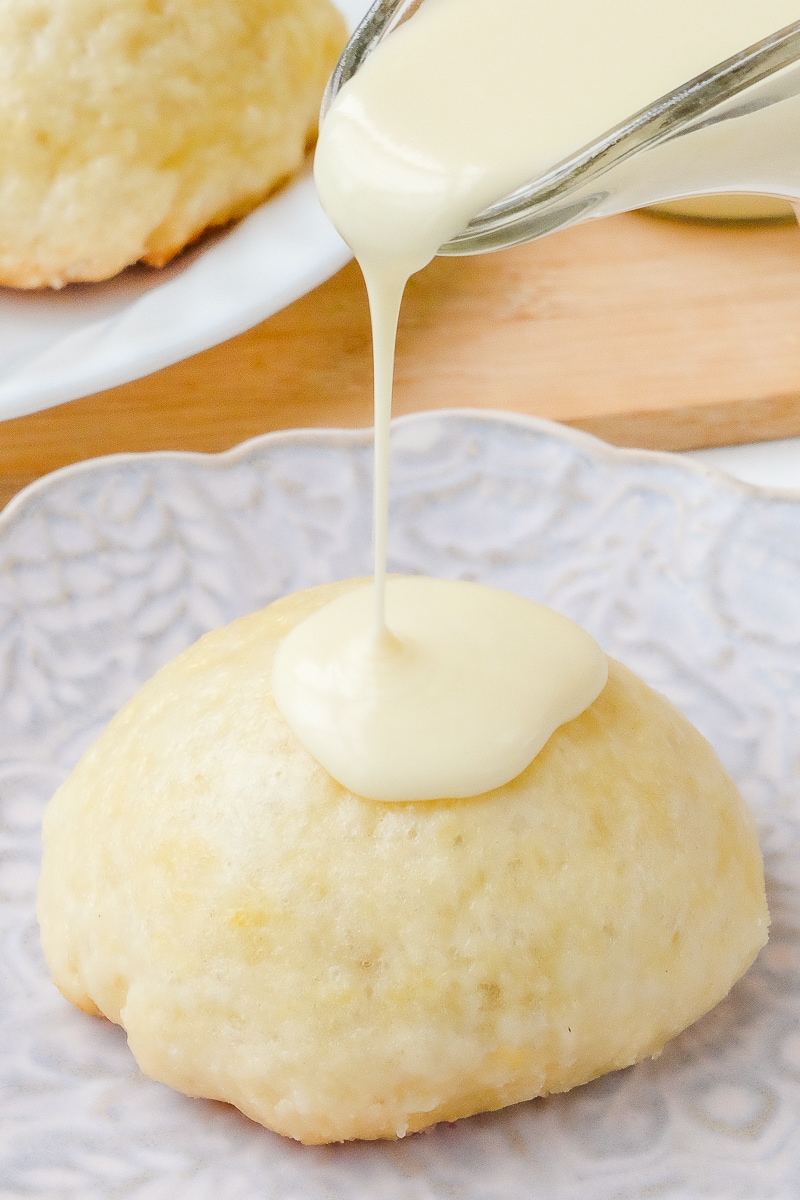
Dampfnudeln are mainly eaten in the south of Germany which is the part of the country that Lisa grew up in.
In case you are not familiar with the German language, you might be confused why we refer to the dumplings as “Dampfnudeln” and not as “Dampfnudel” as most people in North America seem to do.
The word without the “n” at the end is simply the singular form while “Dampfnudeln” is the plural form. Since we are making more than one dumpling, we are mainly using the plural form here!
Other Names for Dampfnudeln
There are actually a number of other names for Dampfnudeln. Aside from just yeast dumplings, in English, they are also sometimes referred to as German steamed bread or even sweet dumplings.
There are other types of yeast dumplings in German cuisine – called Hefeklöße – that differ from Dampfnudeln in the way that they are prepared.
Dampfnudeln are steamed in a pot with a lid – that’s why it makes sense that their literal translation is “steam noodles”. “Dampf”, in German, means steam and “Nudeln”, in German, means noodles.
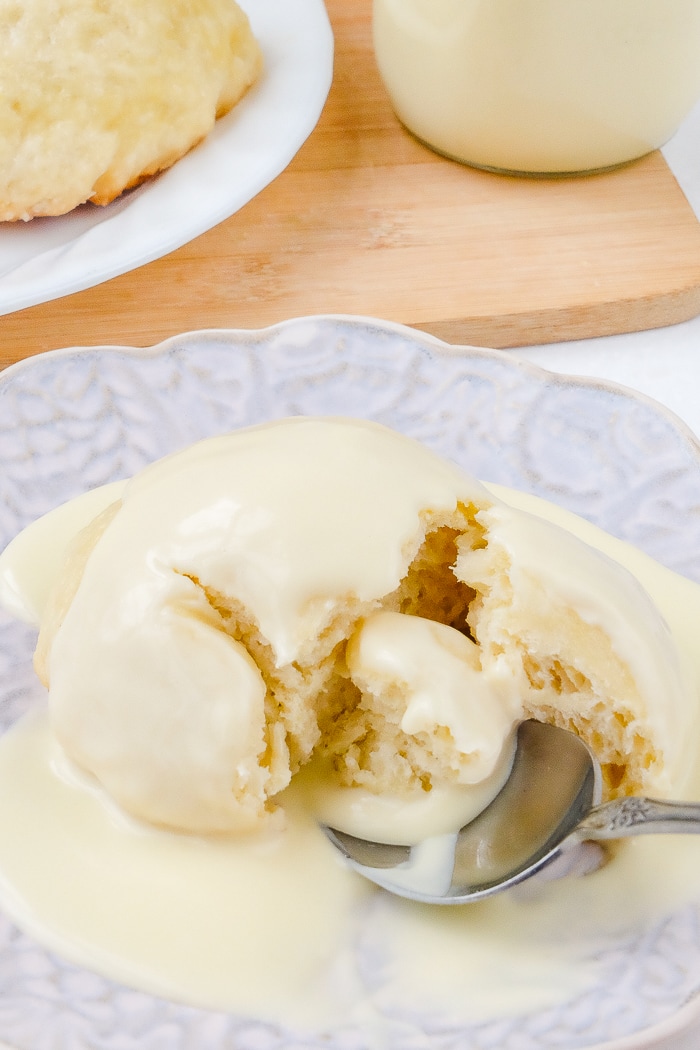
Recipe Tips
Dampfnudeln are actually pretty easy to make – as long as you consider a few things.
- Since these dumplings are made with a yeast dough, it’s important to make sure that your yeast hasn’t expired yet. Expired yeast might prevent the dough from rising the way it should.
- Also, when working with yeast make sure that the other ingredients are at room temperature. We have indicated that in the recipe card below as well. You can use either instant dry yeast or active dry yeast for this recipe. When using active dry yeast, just make sure to dissolve it in some warm milk first.
- To make sure that the Dampfnudeln turn out “fluffy”, make sure to give the dough enough time to rise at the different stages.
- When it comes to steaming the dumplings, it can take a little bit of practice until you know exactly when they are done. Don’t give up if they don’t turn out perfectly the first time. We have tried to make our guidelines for steaming them as specific as possible, but keep in mind that the pan you use can influence the steaming time.
- Also, when steaming the dumplings make sure to not lift the lid to check on them until they are done. Doing so can deflate the dumplings which is not what you want.
How to Make Dampfnudeln – Step by Step Recipe Instructions
If you’d like to make these German yeast dumplings, you can find the recipe card at the bottom of this post with exact ingredients and measurements.
And in case you’d like to see some process photos, you can check them out below.
This way, you will have an idea of what the Dampfnudeln look like at each stage of the recipe!
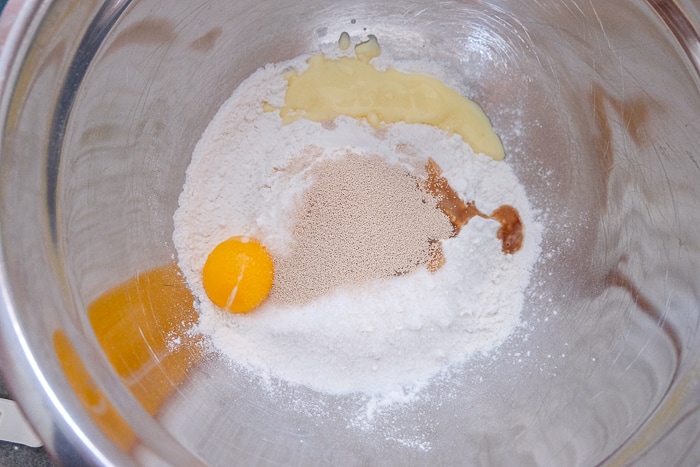
Add the flour, salt, sugar, melted butter, vanilla extract, and egg yolk to a large mixing bowl.
Also either add the milk with the dissolved yeast or just add the instant yeast.
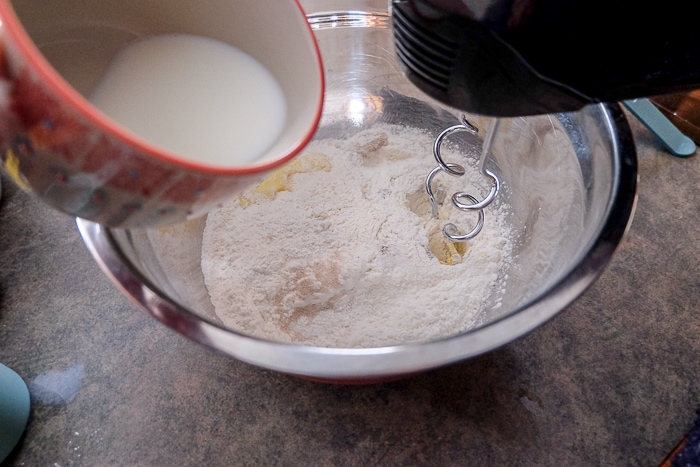
Use the spiral dough hooks of your electric mixer to knead the dough while slowly adding the milk.
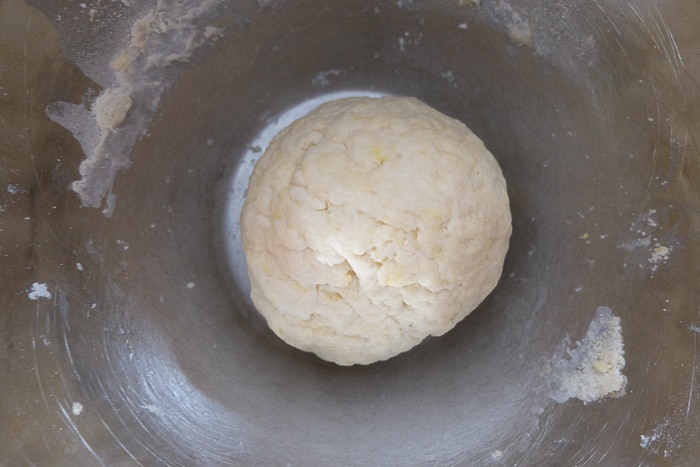
Keep kneading the mixture until everything is well mixed and you can easily form the dough into a ball.
Cover the bowl with the dough with a dishtowel or lid and place it in a warm spot without draft. Allow the dough to rise for 60 minutes.
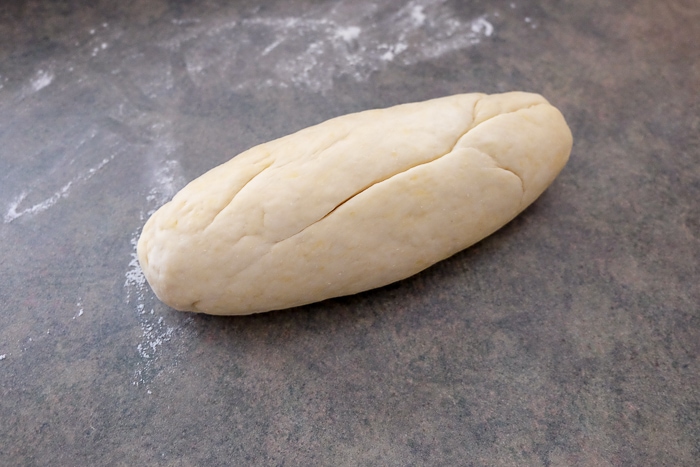
Once the dough has noticeably increased in size, sprinkle a little bit of flour on your countertop. Briefly knead the dough with your hands, then form it into a thick roll.
This will make it easier to cut the dough into equal pieces.
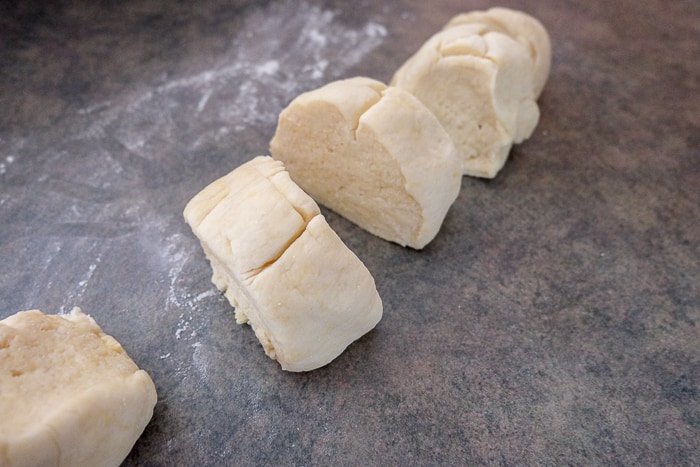
Cut the dough into 5 pieces of equal size.
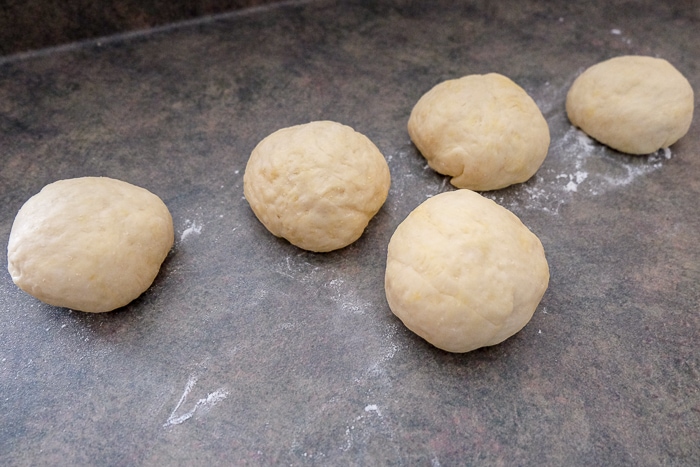
Use the dough pieces to form small round dumplings. Try to keep the “seams” at the bottom so that the balls look relatively smooth at the top.
Press down on the top of the balls slightly with the open palm of your hand. Then let the dumplings rest for another 15 minutes.
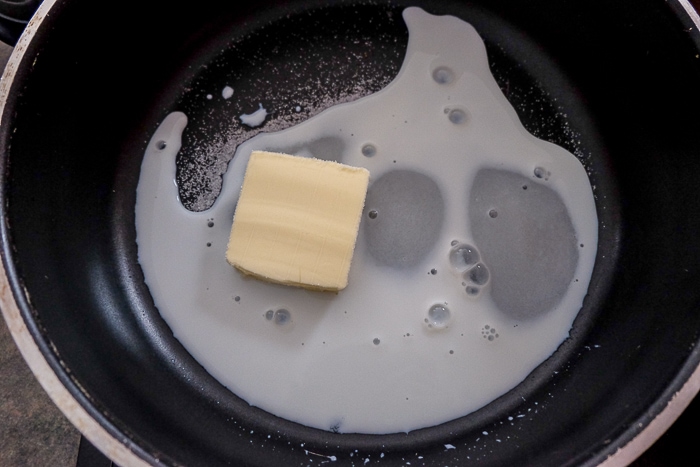
In the meantime, add the butter, sugar, and milk to a large pot with a lid.
Melt the butter on low heat and mix regularly until the sugar has dissolved.
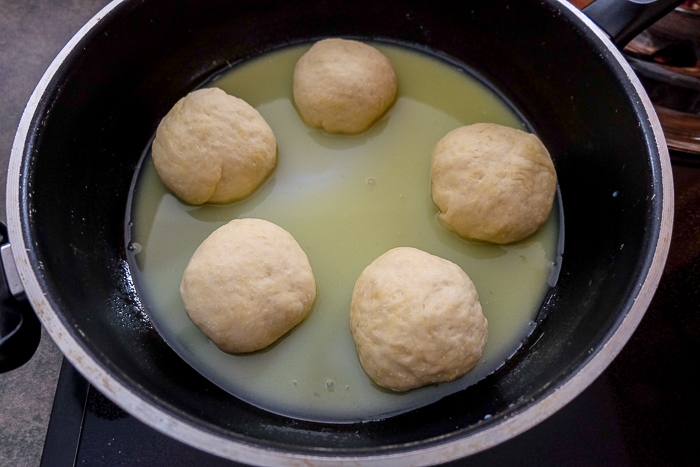
Once the butter has fully melted and the 15 minutes are up, place the dumplings in the pot.
Make sure to space them out as well as possible since they will increase their size noticeably.
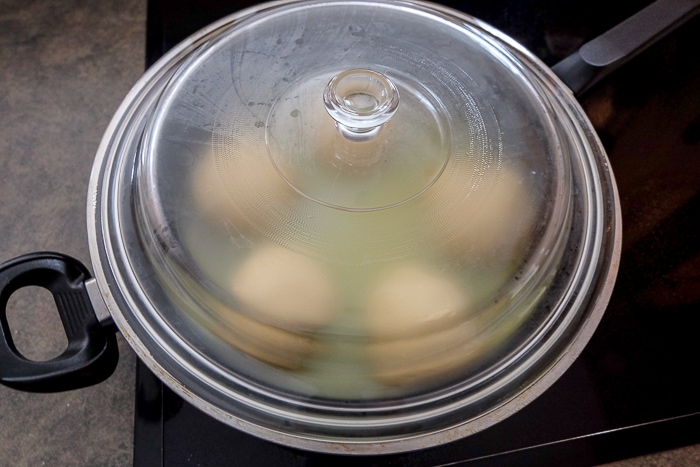
Place the lid on the pot and don’t lift it again until the dumplings are done. Otherwise, they might deflate.
Steam the dumplings on medium heat for around 5-6 minutes. After that, turn down the heat slightly and steam them for 18-22 more minutes.
It’s great if you have a pot with a glass lid since you can see what happens inside the pot. That can be helpful if you’ve never made Dampfnudeln before.
Pay attention when all the milk has evaporated and less steam is produced in the pot. At this point, leave the dumplings in the pan for another minute or two so the bottoms can get nicely golden brown.
However, be careful here and use your judgement since you don’t want to burn the bottom of the dumplings either.
If you don’t have a glass lid, just make sure to listen really closely to the sounds from inside the pot. When the milk has evaporated, the sound will change to more of a sizzling.
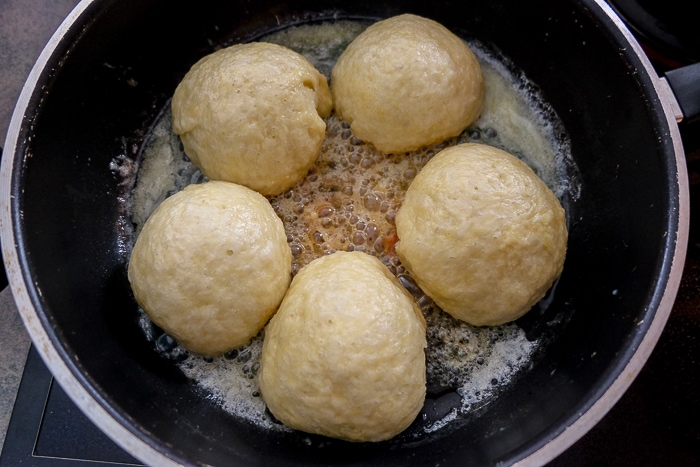
When the dumplings are done, be careful when removing the lid and make sure that the water droplets on the lid don’t hit the dumplings.
The dumplings should have significantly increased in size.
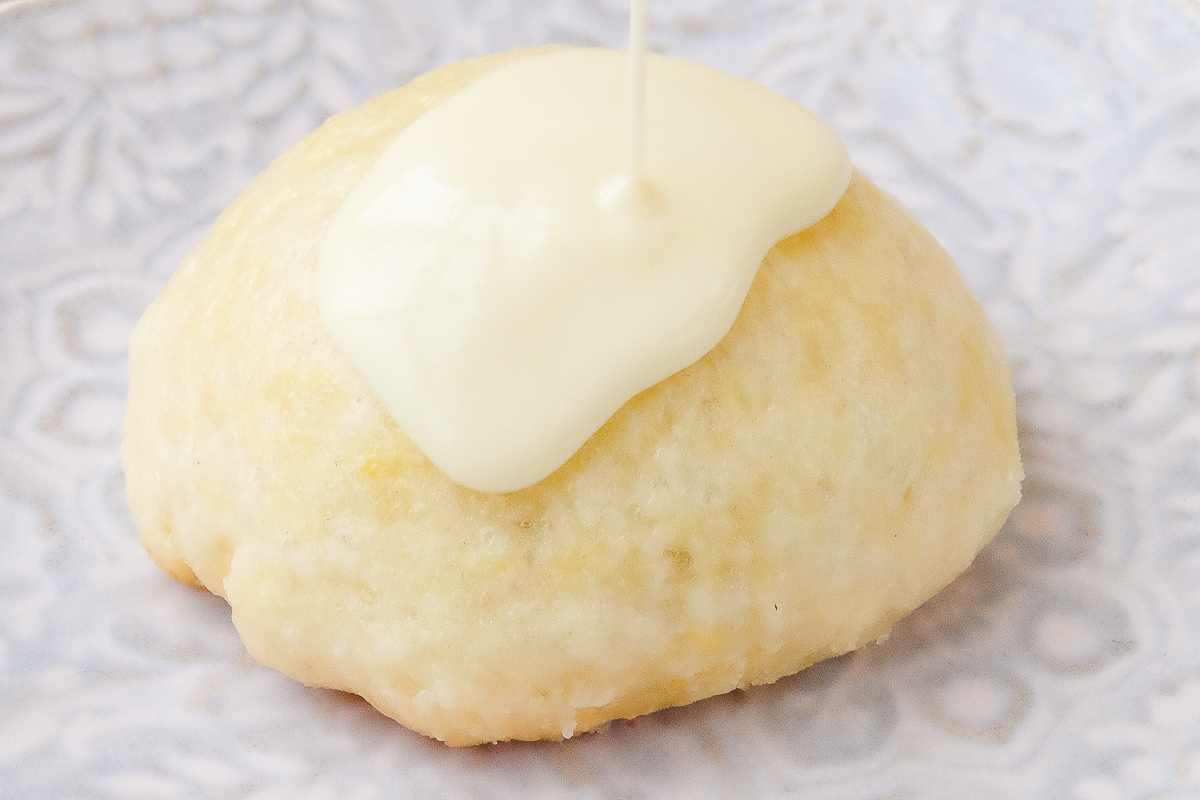
Serve the dumplings right away. As mentioned, we like them with homemade vanilla sauce (which is super easy to make!).
Storage Tips
In our opinion, Dampfnudeln taste best fresh so ideally you only make as many as you’ll need.
However, you can store leftover dumplings in a container in the fridge and reheat them the next day. We like doing this in the microwave with the dumpling already covered in vanilla sauce.
Alternatively, you can also cut the leftover dumplings into slices and fry these in some oil or butter. Enjoy!
FAQ
A Dampfnudel is a steamed dumpling made from a yeast dough.
In English, Dampfnudeln literally means “steam noodles”. However, they are more commonly called German yeast dumplings and not actually considered a noodle.
Dampfnudeln can be enjoyed savory or sweet. Savory is best with gravy and mushrooms or meat. Sweet Dampfnudeln are delicious with homemade vanilla sauce, fruit compote, or a sauce similar to vanilla sauce made with white wine.
To make Dampfnudeln, create the yeast dough, let it rise, shape it into small dumplings and then steam them in a butter-milk-sugar mixture in a large covered pan on the stove. You can refer to the Dampfnudeln recipe for detailed step by step instructions.
Related Recipes
For more German dumpling recipes (or things that are like dumplings), check out these other great dishes:
- Semmelknoedel – German bread dumplings eaten with many different dishes.
- Kartoffelklöße – Classic potato dumplings – just one way to make them!
- Maultaschen – German stuffed pasta (like a dumpling) eaten in a delicious broth.
- Spaetzle – Authentic German egg noodles that can be enjoyed in various different ways.
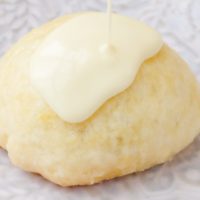
Dampfnudeln (German Yeast Dumplings)
Ingredients
The Dough
- 2 cups all-purpose flour
- 1 1/2 teaspoons dry yeast
- 2 tablespoons sugar
- 2/3 cup milk, warm
- a pinch of salt
- 2 tablespoons butter, melted
- 1 egg yolk from a medium-sized egg
- 1/2 teaspoon vanilla extract
The Ingredients For The Steam Pot
- 1/4 cup butter
- 1/4 cup sugar
- 1/3 cup milk
Instructions
- Add the flour, salt, sugar, melted butter, egg yolk, and vanilla extract to a large mixing bowl. Add the milk with the dissolved yeast – or instant yeast if you’re using that kind of yeast.
- Knead the mixture with the spiral dough hooks of your electric mixer. Slowly add the milk. Keep kneading until the mixture forms a ball that doesn’t stick to the sides of the bowl anymore.
- Use your hands to shape the dough into a nicer looking ball, then cover the bowl that holds the ball of dough with a dishtowel or lid. Place the bowl in a warm spot without draft for 60 minutes to allow the dough to rise.
- After the 60 minutes are up and the dough has increased in size, sprinkle a little bit of flour on your countertop. Knead the dough briefly, then roll it into a thick sausage.
- Cut the dough into 5 pieces of equal size. Form a small ball out of each piece of dough. Make sure that the "seams" are at the bottom of the ball so that the top looks relatively smooth. Press down on the top of the ball slightly so it gets a little squished. Let the balls of dough rest for another 15 minutes.
- In the meantime, heat the butter, sugar, and milk on low heat in a large pot with a lid on the stove.
- After the 15 minutes are up, place the balls of dough into the pot, leaving some space between them (they will increase their size significantly). Place the lid on the pot and DON’T LIFT IT AGAIN until the dumplings are done. Otherwise, they might deflate.
- Steam the dumplings on medium heat for around 5-6 minutes, then turn the heat down slightly and steam them for approx. 18-22 more minutes. Ideally, you use a pot or large flat-bottom saucepan with a glass lid so that you can see the dumplings rise. When the milk has evaporated you will no longer see bubbles forming on the bottom of the pot/pan and less steam will be produced on the inside of the lid. When you reach this point, leave the lid on for another minute so the dumplings can get a nice browned bottom (but not burn so watch/listen carefully). If you don’t have a pot with a glass lid, just make sure to listen really carefully. The sound from inside the pot will change when the milk is gone – it will sound more like a sizzling. When lifting the lid, make sure that no water droplets hit the dumplings.
- Serve the dumplings right away. They taste delicious with homemade vanilla sauce!
Notes
- We are using instant dry yeast for this recipe. If you’re using active dry yeast (the one that has to be dissolved first), heat 1/3 cup of milk in the microwave or on the stove until warm. Add the yeast, and let the mixture sit for around 10 minutes until the yeast has dissolved and becomes active (it starts to bubble slightly). Then add the yeast at the step when you add the milk. Just remember to account for the 1/3 cup of milk and only add another 1/3 cup to the bowl.
- Keep an eye on the dumplings at the end and use the above indicators to finish off the steaming. Be careful not to overcook or else the bottom of the dumplings can burn once the moisture is all gone from inside the pot. It can take a bit of practice, so don’t give up if they didn’t turn out perfect the first time!
- Make sure that you are using yeast that hasn’t expired yet. Otherwise, your dough might not rise. Also, make sure that the milk you are adding to the dough is warm and not boiling as this might also negatively affect the yeast bacteria.
- Dampfnudeln taste best fresh, but you can try to reheat them the next day. We sometimes do that in the microwave with vanilla sauce already on it to give the dumpling some moisture back. Alternatively, you can also cut any leftover dumplings into slices and then fry them in some oil or butter the next day.
Nutrition
This nutritional information has been estimated by an online nutrition calculator. It should only be seen as a rough calculation and not a replacement for professional dietary advice.
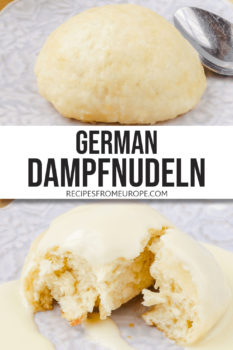
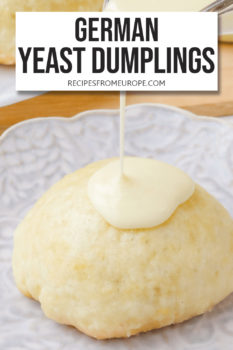

My MIL taught me how to make these 45 years ago. The basic recipe is very similar. The difference is in the steam/fry cooking.
I use a deep skillet with a dome shaped lid that allows the dough room to expand as it cooks. Preheat the pan on medium high heat with just enough vegetable oil to coat the bottom of your pan. Then add 1 cup of water and a generous sprinkle of kosher salt to the pan. When the water boils, add the individual dumpfnoodles to the pan. I usually do 4-5 per batch and this recipe yields 12 decent sized dumpfnoodles
We normally eat these with a thick soup or stew. Great for sponging up the contents of your bowl. Oh and IF there are leftovers, I keep them in a ziplock bag until the next day. Reheat in the oven or microwave wrapped in damp paper towel so it doesn’t dry out.
Thanks for pointing out the sweet side of this family favorite.
Thanks for your comment and for sharing your version, Sue! I’m so used to eating them sweet that your comment is a great reminder that I should make Dampfnudeln as a side with soups and stews more often.
Best recipe, looks and tastes great every time I make it. Thank you!
Thanks so much for your comment, I’m glad you like it!